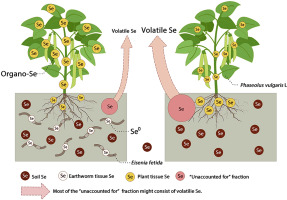Environmental Pollution ( IF 8.9 ) Pub Date : 2020-01-23 , DOI: 10.1016/j.envpol.2020.114048 Azhar-U-Ddin 1 , Jung-Chen Huang 1 , Xinyu Gan 1 , Shengbing He 1 , Weili Zhou 1

|
Selenium (Se) is an essential micronutrient for animals with a narrow margin between essentiality and toxicity. Se toxicity is largely related to inorganic forms of Se in soil, i.e., selenite and selenate that enter food chains through plant uptake, threatening higher trophic level organisms. This experiment investigated effects of earthworm activity on Se bioavailability in soil and the subsequent plant uptake, using earthworm Eisenia fetida and bean plant Phaseolus vulgaris L, both exposed to either selenite or selenate at 1 or 4 mg Se kg−1 for 16 weeks. Plants took up selenate (up to 221-fold) faster than selenite, with up to 84% of the Se rapidly transported to shoots. In the presence of earthworms, Se accumulation obviously increased for selenate-supplied plants, leading to an up to 4% increase in Se translocation factor for all treatments except for 1 mg kg−1 selenite treatment. Earthworms also concentrated Se faster in tissues (up to 274 mg kg−1 DW) at exposure to selenate. For Se toxicity, Se speciation analysis was conducted on the plants and earthworms using XAS. Compared to worm-free treatments, the percentage of organo-Se, i.e., SeMet and CysSeSeCys, increased in beans (up to 34%) in the presence of earthworms for selenate, while the elemental Se portion was significantly reduced or absent, opposite to the results for selenite. Surprisingly, elemental Se (up to 65%) dominated earthworms, regardless of the form of Se supplied. In conclusion, earthworms clearly enhanced Se uptake and translocation in plants, leading to elevated Se levels in shoots. To prevent resulting hazards to humans and other animals, caution should be taken while consuming the shoots, particularly beans, harvested from the Se contaminated soil where earthworm activity is high. Finally, the significant reduction in soil Se suggests phytoextraction of Se from the soil could be improved using earthworms as an aid to plants.
中文翻译:

EEetania fetida与豆类菜豆菜豆对土壤硒命运的交互作用。
硒(Se)是动物必需的微量营养素,其必需性和毒性之间的差异很小。硒的毒性在很大程度上与土壤中硒的无机形式有关,即通过植物吸收进入食物链的亚硒酸盐和硒酸盐,威胁着较高营养水平的生物。本实验使用earth Eisenia fetida和豆类菜豆菜豆(Phaseolus vulgaris L)研究worm活性对土壤中Se的生物利用度及其后续植物吸收的影响,这些both都暴露于1或4 mg Se kg -1的亚硒酸盐或硒酸盐中持续16周。植物吸收硒酸盐的速度(高达221倍)比亚硒酸盐快,高达84%的硒迅速转移到芽上。在worm的存在下,硒酸盐提供的植物中硒的积累明显增加,除1 mg kg -1亚硒酸盐处理外,所有处理均导致硒转运因子增加高达4%。also还可以更快地将硒富集到组织中(高达274 mg kg -1DW)暴露于硒酸盐。对于硒的毒性,使用XAS对植物和earth进行了硒形态分析。与无蠕虫处理相比,在earth存在硒酸盐的情况下,豆类中有机硒(即SeMet和CysSeSeCys)的百分比增加(最多34%),而元素硒部分显着减少或缺失,与亚硒酸盐的结果。出乎意料的是,无论提供的硒形式如何,元素硒(高达65%)都以earth为主。总之,earth明显增强了植物对硒的吸收和转运,导致芽中硒含量升高。为了防止对人类和其他动物造成危害,食用从worm活动度高的硒污染土壤中收获的芽,特别是豆类时,应格外小心。最后,



























 京公网安备 11010802027423号
京公网安备 11010802027423号